Texas Instruments Bundle
Can Texas Instruments Continue Its Semiconductor Dominance?
From its humble beginnings in 1930 as Geophysical Service Incorporated, Texas Instruments (TI) has evolved into a global leader in the semiconductor industry. Its journey, marked by groundbreaking innovations like the transistor and the integrated circuit, showcases a remarkable ability to adapt and thrive. Today, we delve into the Texas Instruments SWOT Analysis to understand its current position and future trajectory.
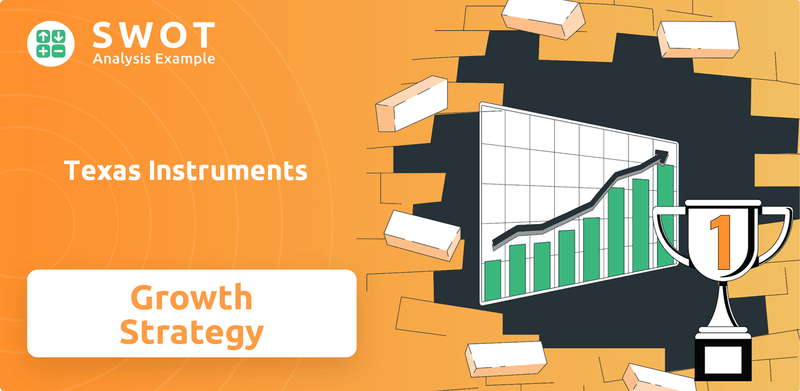
This analysis will explore the core components of Texas Instruments growth strategy, examining its expansion plans, innovation in semiconductors, and financial performance analysis. We'll also investigate the TI market share, competitive advantages, and potential challenges within the dynamic semiconductor industry. Understanding the Texas Instruments future prospects requires a deep dive into its business model explained, revenue growth drivers, and long-term growth potential, providing valuable insights for investors and industry watchers alike.
How Is Texas Instruments Expanding Its Reach?
As part of its Owners & Shareholders of Texas Instruments, TI is heavily investing in expanding its manufacturing capabilities. The company's primary goal is to boost its internal wafer production, strengthening its supply chain and controlling costs. This strategic move is a key element of their long-term growth strategy.
The company is focusing on significant capital expenditures, particularly in its 300mm wafer fabrication facilities. These facilities are crucial for producing the semiconductors that power various electronic devices. This expansion is designed to position TI as a leader in the semiconductor industry.
The company's expansion plans include substantial investments in facilities in Texas and Utah. These investments are supported by the U.S. CHIPS Act, providing financial assistance to boost domestic semiconductor production.
TI's capital expenditure was $4.82 billion in 2024. The company projects to spend around $5 billion annually through 2025. This investment is part of a multi-year plan to establish a dependable, low-cost 300mm capacity.
TI aims to produce over 95% of its wafers internally by 2030. More than 80% of these wafers will be produced on 300mm. This strategy aims to enhance supply chain resilience and control costs.
TI anticipates receiving between $7.5 billion to $9.5 billion through 2034. This funding includes direct funding and investment tax credits. These funds will support TI's expansion efforts.
Industrial and automotive markets represented about 70% of TI's revenue in 2024. These markets are expected to grow faster than the overall semiconductor market. TI is strategically positioned in these high-growth sectors.
TI is strategically expanding its presence in the industrial and automotive markets. These sectors are crucial for the company's revenue and future growth. The company is also increasing its direct engagement with customers.
- Industrial market revenue increased by 8-9% in Q1 2025.
- Automotive market revenue increased by 3-4% in Q1 2025.
- Approximately 80% of revenue was transacted directly in 2024.
- Direct customer engagement provides better insights into design projects.
Texas Instruments SWOT Analysis
- Complete SWOT Breakdown
- Fully Customizable
- Editable in Excel & Word
- Professional Formatting
- Investor-Ready Format
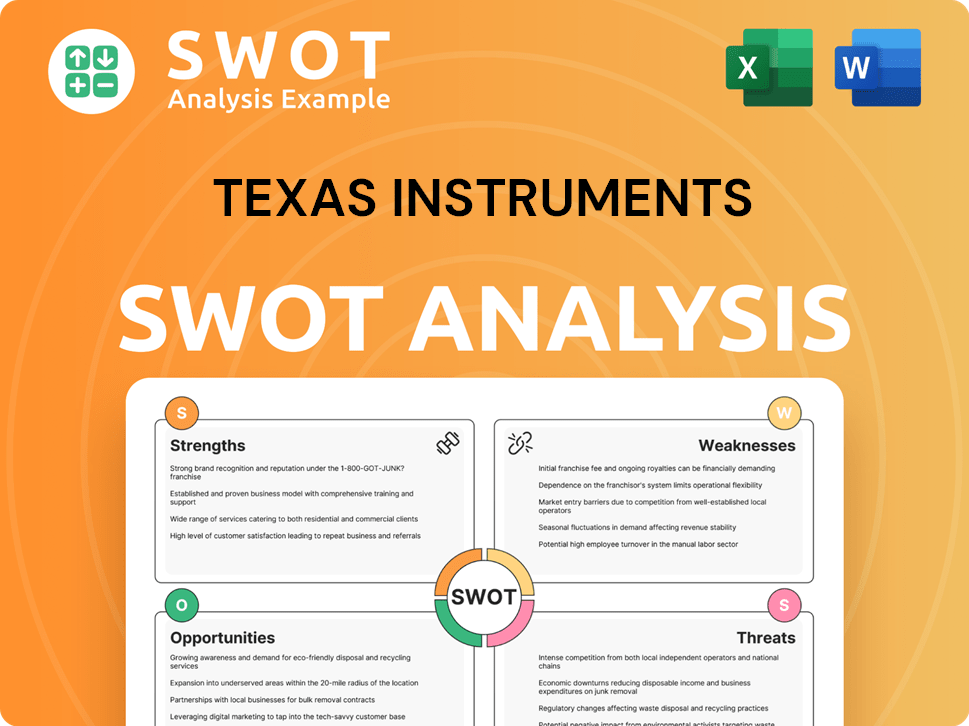
How Does Texas Instruments Invest in Innovation?
The growth strategy of Texas Instruments (TI) hinges on its dedication to innovation and technology, which is fueled by substantial investments in research and development (R&D). This commitment is crucial for maintaining its competitive edge within the semiconductor industry and driving future prospects. TI's ability to consistently introduce new products and enhance its existing portfolio is a key element of its success.
TI's approach involves a strong focus on advanced manufacturing processes, particularly vertical integration, which provides greater control over quality, costs, and supply chain resilience. This strategy is essential for navigating the complexities of the semiconductor market and ensuring long-term sustainability. The company's strategic investments in expanding its manufacturing capabilities, including the development of 300mm wafer technology, are vital for achieving scale and cost reduction.
The company's financial performance analysis reveals that TI's R&D expenses are significant. For the twelve months ending March 31, 2025, R&D spending reached $1.998 billion, a 5.94% increase year-over-year. In 2024, TI invested $1.959 billion in R&D, marking a 5.15% increase from the previous year. These figures underscore TI's commitment to innovation and its ability to maintain a competitive advantage in the market.
TI's substantial R&D investments are a cornerstone of its growth strategy. These investments are crucial for driving innovation and maintaining a competitive edge in the semiconductor industry.
Vertical integration allows TI to control quality, costs, and supply chain resilience. This strategic approach is essential for navigating market complexities and ensuring long-term sustainability.
TI's expansion plans include ramping up production in RFAB2 and LFAB1, and constructing SM1, SM2, and LFAB2. These expansions are key to achieving scale and cost reduction.
The focus on 300mm wafer technology is central to TI's manufacturing strategy. This technology is essential for achieving economies of scale and reducing production costs.
TI aims to achieve over 95% internal wafer production by 2030. This goal aligns with the U.S. CHIPS Act, which provides incentives for domestic semiconductor manufacturing.
TI's diverse product portfolio, focusing on analog and embedded processing products, supports advancements in areas like AI and IoT. This broad portfolio strengthens its market position.
TI's innovation and technology strategy is multifaceted, encompassing significant R&D investments, vertical integration, and strategic manufacturing expansions. These elements are critical to the company's long-term growth potential and competitive advantages in the semiconductor industry. The company's focus on internal wafer production and alignment with the U.S. CHIPS Act further solidify its position.
- R&D Investments: Sustained investments in R&D are crucial for introducing new products and enhancing existing ones.
- Vertical Integration: Owning its manufacturing processes provides greater control over quality, costs, and supply chain resilience.
- 300mm Wafer Technology: This technology is central to TI's manufacturing expansion, aiming for scale and cost reduction.
- Manufacturing Expansion: Ramping up production in existing facilities and constructing new ones.
- Internal Wafer Production: Targeting over 95% internal wafer production by 2030.
For a deeper understanding of TI's competitive landscape, consider exploring the Competitors Landscape of Texas Instruments.
Texas Instruments PESTLE Analysis
- Covers All 6 PESTLE Categories
- No Research Needed – Save Hours of Work
- Built by Experts, Trusted by Consultants
- Instant Download, Ready to Use
- 100% Editable, Fully Customizable
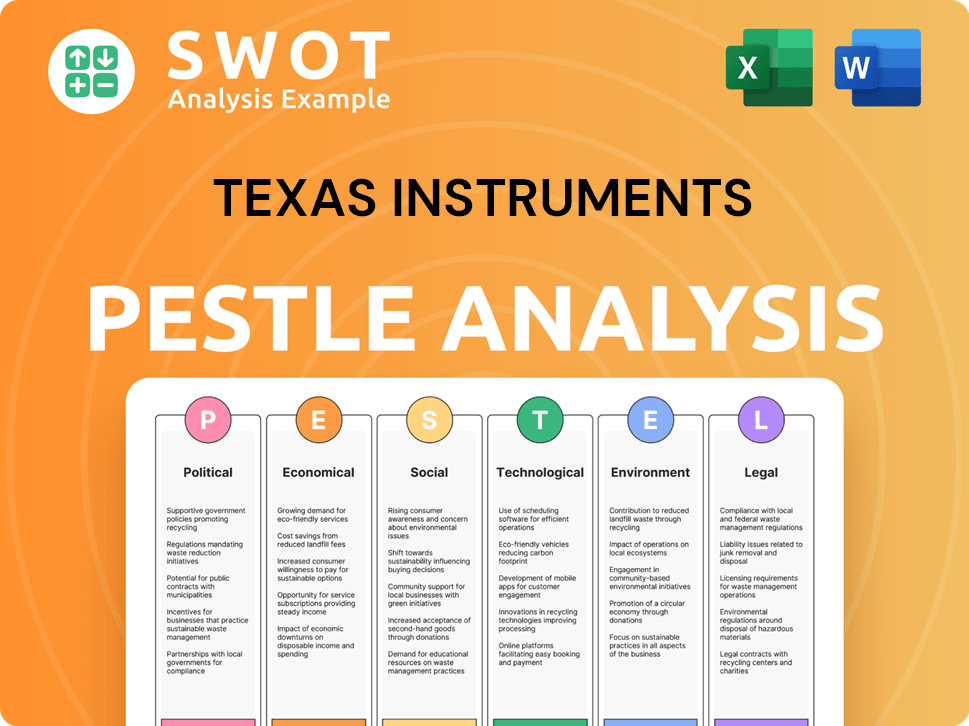
What Is Texas Instruments’s Growth Forecast?
The financial outlook for Texas Instruments (TI) is centered on long-term growth, mainly driven by its commitment to free cash flow per share. This strategy is supported by substantial capital expenditures and a focus on key markets. The company's performance and future plans provide insights into its potential within the semiconductor industry.
For 2024, TI reported a revenue of $15.641 billion, an 11% decrease from the previous year, reflecting broader market trends. However, the company is positioning itself for future growth through strategic investments. This includes significant capital expenditures to expand manufacturing capabilities, which is expected to drive future financial performance.
Looking ahead to 2025 and beyond, TI's strategy includes a focus on expanding its manufacturing capacity. This is supported by substantial capital expenditures, with approximately $5 billion annually projected through 2025. This investment is expected to position TI for future growth, with projected free cash flow per share ranging from $8 to $12 by 2026.
In 2024, TI's revenue reached $15.641 billion, an 11% decrease compared to $17.519 billion in 2023. Net income for 2024 decreased by 25% year-on-year to $4.799 billion. Diluted earnings per share were $5.20, down 26% from $7.07 in 2023.
Q1 2025 revenue was $4.07 billion, an 11% increase from the same quarter a year ago and a 2% increase sequentially. This indicates a potential market recovery and positive momentum. Free cash flow for the same period was $1.7 billion as of Q1 2025.
For Q2 2025, TI anticipates revenue in the range of $4.17 billion to $4.53 billion and earnings per share between $1.21 and $1.47. Analysts expect TXN to report an EPS of $5.08 for fiscal 2024, and for fiscal 2025, EPS is projected to grow by 12.6% year-over-year to $5.72.
Longer-term projections suggest an average estimated EPS of $5.53 for 2025, rising to $6.67 in 2026, and $7.83 in 2027, with an estimated $11.53 by 2029, implying a substantial EPS CAGR of approximately 20.17% through 2029.
Despite the recent revenue decline, TI generated strong cash flow from operations of $6.318 billion for the trailing twelve months in 2024. The company also maintains a commitment to shareholder returns, increasing its dividend by 5% in 2024 and returning $5.724 billion to shareholders through dividends and stock repurchases in the same year. TI expects to receive between $7.5 billion to $9.5 billion through 2034 from the CHIPS Act, which includes investment tax credits and direct funding for its wafer fabs. For more insights, you can explore the Marketing Strategy of Texas Instruments.
Texas Instruments Business Model Canvas
- Complete 9-Block Business Model Canvas
- Effortlessly Communicate Your Business Strategy
- Investor-Ready BMC Format
- 100% Editable and Customizable
- Clear and Structured Layout
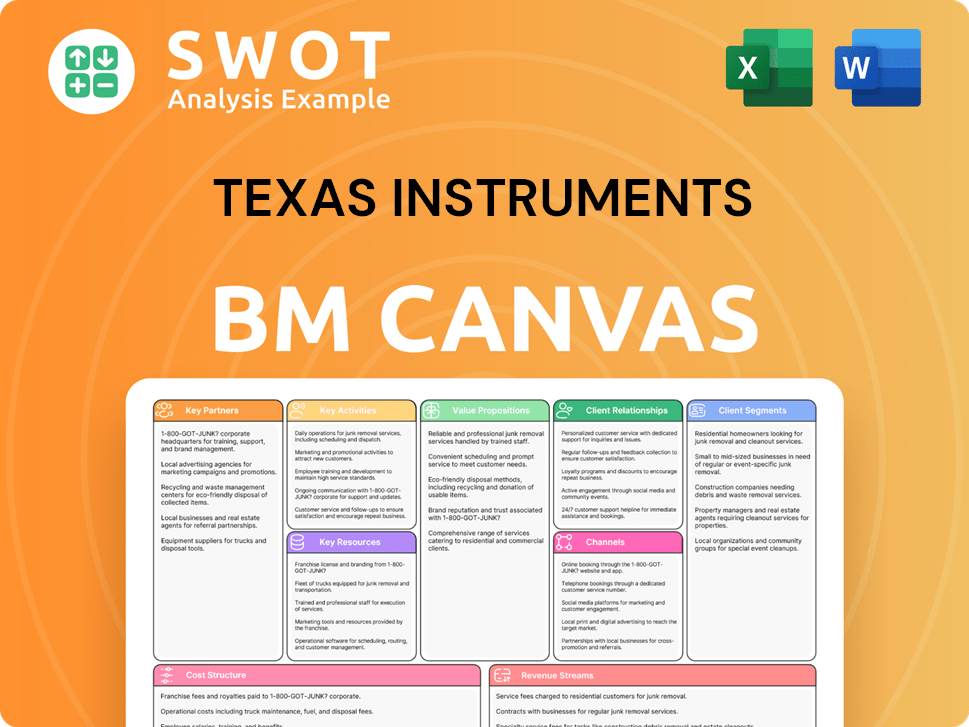
What Risks Could Slow Texas Instruments’s Growth?
The Texas Instruments growth strategy faces several potential risks and obstacles that could impact its future prospects. These challenges primarily stem from the cyclical nature of the semiconductor industry and the intensity of market competition. Understanding these risks is crucial for a comprehensive TI company analysis and assessing the Texas Instruments investment outlook.
TI market share and financial performance are vulnerable to fluctuations in demand and inventory levels, as seen by the revenue decline from 2023 to 2024, with revenue reaching $15.64 billion in 2024. The company's ability to navigate the cyclical downturn and capitalize on the expected recovery in 2025 is a key factor in its long-term success. The Texas Instruments stock performance is closely tied to its ability to mitigate these risks.
The industrial market, which accounted for approximately 34% of TI's revenue in 2024, is experiencing significant declines in some subsegments. Continued weak demand, especially in this sector, could pressure margins and strain free cash flow. The increasing importance of artificial intelligence and advanced computing intensifies the competition, potentially impacting the company's TI market share.
Competitors developing more innovative products or securing key customer relationships pose a constant threat to TI's market share. The rapid advancement in AI and computing further intensifies the competitive landscape. This requires continuous innovation and strategic adaptation to maintain a competitive edge.
The expansion of global semiconductor manufacturing capacity carries the risk of oversupply in certain product categories. This could lead to pricing pressures and margin compression, affecting Texas Instruments financial performance analysis. Careful market analysis and strategic planning are essential to mitigate this risk.
While TI is investing heavily in internal manufacturing, supply chain vulnerabilities remain a potential obstacle. The company's goal to produce over 95% of its wafers internally aims to enhance resilience. The execution of this capital expenditure program presents its own challenges and execution risks, which could impact financial results.
Regulatory changes, particularly those related to international trade and technology transfers, could affect TI's global operations. Geopolitical factors can influence supply chains and market access. These factors require proactive risk management and adaptability in the TI company analysis.
Managing the large manufacturing expansion and navigating the cyclical recovery simultaneously presents a complex challenge. This could impact financial performance and investor confidence. Effective execution of the expansion plans is crucial for long-term Texas Instruments growth strategy.
Cybersecurity incidents pose a risk to operations and data security. Texas Instruments addresses these risks through regular tabletop exercises, threat hunting, and red team exercises. Proactive cybersecurity measures are crucial for maintaining operational integrity.
TI's management focuses on strengthening competitive advantages, disciplined capital allocation, and pursuing efficiencies. This includes investments in internal manufacturing to enhance supply chain resilience. Regular risk assessments and proactive measures are essential for navigating these challenges. For further insights, see the Texas Instruments business model explained.
The risks outlined can significantly impact TI's financial performance. Revenue declines, margin pressures, and increased operational costs are potential outcomes. The company's ability to manage these challenges will determine its Texas Instruments revenue growth drivers and overall success. For a detailed view, consider a comprehensive Texas Instruments financial performance analysis.
Texas Instruments Porter's Five Forces Analysis
- Covers All 5 Competitive Forces in Detail
- Structured for Consultants, Students, and Founders
- 100% Editable in Microsoft Word & Excel
- Instant Digital Download – Use Immediately
- Compatible with Mac & PC – Fully Unlocked
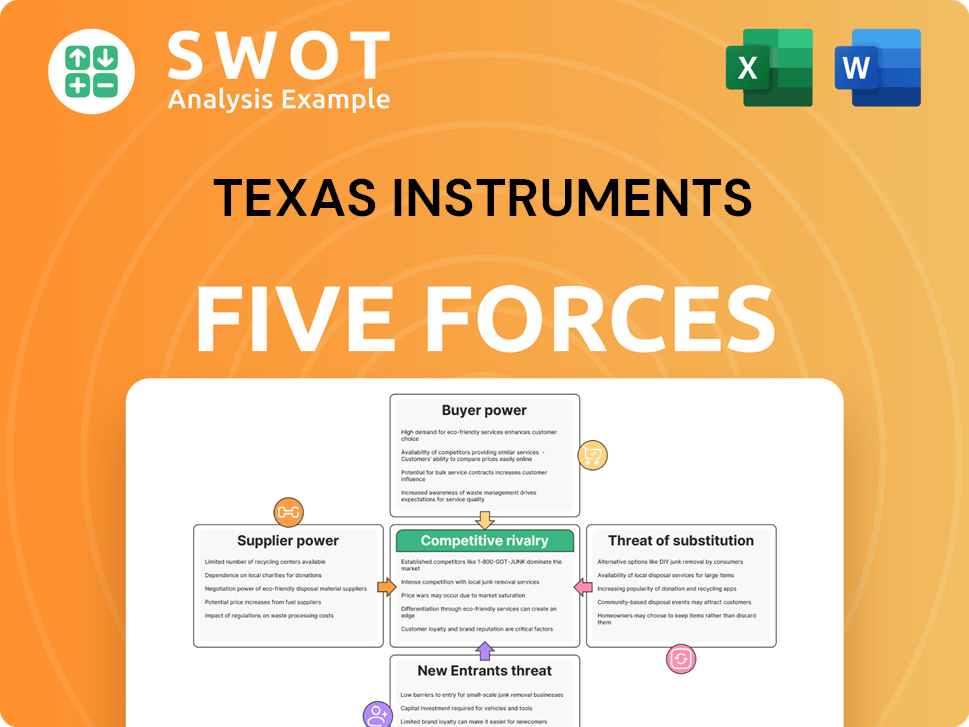
Related Blogs
- What are Mission Vision & Core Values of Texas Instruments Company?
- What is Competitive Landscape of Texas Instruments Company?
- How Does Texas Instruments Company Work?
- What is Sales and Marketing Strategy of Texas Instruments Company?
- What is Brief History of Texas Instruments Company?
- Who Owns Texas Instruments Company?
- What is Customer Demographics and Target Market of Texas Instruments Company?
Disclaimer
All information, articles, and product details provided on this website are for general informational and educational purposes only. We do not claim any ownership over, nor do we intend to infringe upon, any trademarks, copyrights, logos, brand names, or other intellectual property mentioned or depicted on this site. Such intellectual property remains the property of its respective owners, and any references here are made solely for identification or informational purposes, without implying any affiliation, endorsement, or partnership.
We make no representations or warranties, express or implied, regarding the accuracy, completeness, or suitability of any content or products presented. Nothing on this website should be construed as legal, tax, investment, financial, medical, or other professional advice. In addition, no part of this site—including articles or product references—constitutes a solicitation, recommendation, endorsement, advertisement, or offer to buy or sell any securities, franchises, or other financial instruments, particularly in jurisdictions where such activity would be unlawful.
All content is of a general nature and may not address the specific circumstances of any individual or entity. It is not a substitute for professional advice or services. Any actions you take based on the information provided here are strictly at your own risk. You accept full responsibility for any decisions or outcomes arising from your use of this website and agree to release us from any liability in connection with your use of, or reliance upon, the content or products found herein.